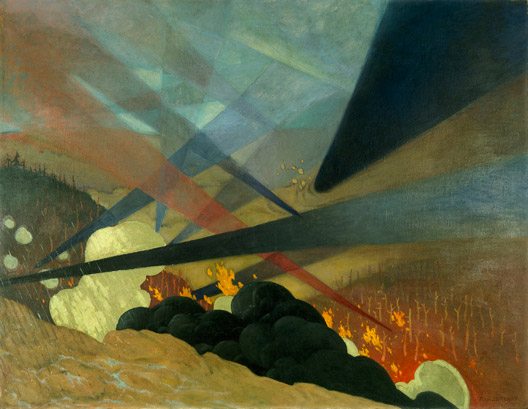Fr : version française / En: english version
Caught in the cross fire
The line of fire is synonymous with the front. Fire symbolizes war because it evokes the same terror. Fire has also been an all too common part of the arsenal of armies in every era, both as a defensive (scorched earth policy) and offensive weapon.
Under fire
Abruptly, across all the width of the opposite slope, lurid flames burst forth that strike the air with terrible detonations. In line from left to right fires emerge from the sky and explosions from the ground. It is a frightful curtain which divides us from the world, which divides us from the past and from the future. We stop, fixed to the ground, stupefied by the sudden host that thunders from every side; then a simultaneous effort uplifts our mass again and throws it swiftly forward. We stumble and impede each other in the great waves of smoke. With harsh crashes and whirlwinds of pulverized earth, towards the profundity into which we hurl ourselves pell-mell, we see craters opened here and there, side by side, and merging in each other. Then one knows no longer where the discharges fall. Volleys are let loose so monstrously resounding that one feels himself annihilated by the mere sound of the downpoured thunder of these great constellations of destruction that form in the sky. One sees and one feels the fragments passing close to one's head with their hiss of red-hot iron plunged in water. The blast of one explosion so burns my hands that I let my rifle fall. I pick it up again, reeling, and set off in the tawny-gleaming tempest with lowered head, lashed by spirits of dust and soot in a crushing downpour like volcanic lava.
Excerpt from Under Fire, by Henri Barbusse (1916 winner of the Goncourt award).
Translated from the French by Fitzwater Wray.
The Greek fire of the Byzantines terrorized the barbarians and conquered cities were frequently burned to the ground. Firearms, grenades, flame-throwers, incendiary bombs, napalm: humans demonstrate an endlessly surprising, relentless creativity when it comes to finding ways to torch their neighbor!





























